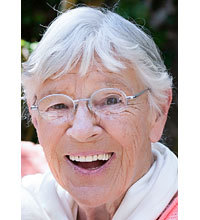
Bernadette today
(Concluded from Part 1, yesterday.)
Bibliography
ENS: Berandette Roberts, The Experience of No-Self. A Contemplative Journey. Boston and London: Shamballa, 1985.
PNS: Bernadette Roberts, Path to No-Self. Boston and London: Shamballa, 1985.
PNS2: Bernadette Roberts, “The Path to No-Self” in Stephan Bodian, ed. Timeless Visions, Healing Voices. Freedom, CA: Crossing Press, 1991.
Two Movements
I don’t think we should get locked in to any stage theory [of enlightenment]; it is always someone else’s retrospective view of his or her own journey, which may not include our experiences or insights. Our obligation is to be true to our own insights, our own inner light. (PNS2, 131.)
I am convinced that the contemplative life is composed of two distinct and separate movements, well marked and defined by the nature of their experiences alone. The first movement is toward self’s union with God which runs parallel with the psychological process of integration, wherein the emphasis is on interior trials and dark nights by which the self is established in a permanent union with God — the still-point and axis of its being. In this process we discover that the self is not lost; rather a new self has been found that now functions as an undivided unit from its deepest, innermost center.
Following this first movement is an interval (twenty years in my case) during which this union is tested. … It seems that at the end of this [intervening] period a point is reached where the self is so completely aligned with the still-point it can no longer be moved, even in its first movements, from this center. It can no longer be tested by any force or trial, nor moved by the winds of change, and at this point the self has obviously outgrown its function; it is no longer needed or useful and life can go on without it. We are ready to move on, to go beyond the self, beyond even its most intimate union with God, and this is where we enter yet another new life — a life best categorized, perhaps, as a life without a self. (ENS, 11-2.)
The onset of this second movement is characterized by the falling away of the self and a coming upon of “that” which remains when it is gone. But this going-out is an upheaval, a complete turnabout of such proportions it cannot possibly be missed, under-emphasized, or sufficiently stressed as a landmark in the contemplative life. It is far more than the discovery of life without a self. The immediate, inevitable result is a change of consciousness, an emergence into a new way of knowing that entails a tremendous readjustment when the self can no longer be an object of awareness. The reflexive mechanism of the mind — or whatever it is that allows us to be self-conscious — is cut off or permanently suspended so the mind is ever after in a fixed now-moment, out of which it cannot move in its uninterrupted gaze upon the Unknown.
This journey, then, is nothing more, yet nothing less, that a period of acclimating to a new way of seeing; a time of transition and revelation as it gradually comes upon “that” which remains when there is no self. This is not a journey for those who expect love and bliss; rather, it is for the hardy who have been tried in fire and have come to rest in the tough, immoveable trust in “that” which lies beyond the known, beyond the self, beyond union, and even beyond love and trust itself. (ENS, 12-3.)

